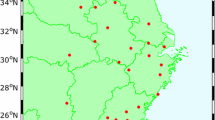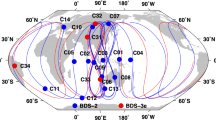Abstract
The main challenge of ambiguity resolution in precise point positioning (PPP) is that it requires 30 min or more to succeed in the first fixing of ambiguities. With the full operation of the BeiDou (BDS) satellite system in East Asia, it is worthwhile to investigate the performance of GPS + BDS PPP ambiguity resolution, especially the improvements of the initial fixing time and ambiguity-fixing rate compared to GPS-only solutions. We estimated the wide- and narrow-lane fractional-cycle biases (FCBs) for BDS with a regional network, and PPP ambiguity resolution was carried out at each station to assess the contribution of BDS. The across-satellite single-difference (ASSD) GPS + BDS combined ambiguity-fixed PPP model was used, in which the ASSD is applied within each system. We used a two-day data set from 48 stations. For kinematic PPP, the percentage of fixing within 10 min for GPS only (Model A) is 17.6 %, when adding IGSO and MEO of BDS (Model B), the percentage improves significantly to 42.8 %, whereas it is only 23.2 % if GEO is added (Model C) due to the low precision of GEO orbits. For static PPP, the fixing percentage is 32.9, 53.3 and 28.0 % for Model A, B and C, respectively. In order to overcome the limitation of the poor precision of GEO satellites, we also used a small network of 10 stations to analyze the contribution of GEO satellites to kinematic PPP. We took advantage of the fact that for stations of a small network the GEO satellites appear at almost the same direction, such that the GEO orbit error can be absorbed by its FCB estimates. The results show that the percentage of fixing improves from 39.5 to 57.7 % by adding GEO satellites.














Similar content being viewed by others
References
Boehm J, Niell A, Tregoning P, Schuh H (2006) Global mapping function (GMF): a new empirical mapping function based on numerical weather model data. Geophys Res Lett 33:L7304. doi:10.1029/2005GL025546
Collins P, Lahaye F, Hérous P, Bisnath S (2008) Precise point positioning with AR using the decoupled clock model. In Proceedings of ION GNSS 2008. Institute of Navigation, Savannah, GA, 16–19 September, pp 1315–1322
Dach R, Brockmann E, Schaer S et al (2009) GNSS processing at CODE: status report. J Geod 83(3–4):353–365
Gabor MJ, Nerem RS (1999) GPS carrier phase AR using satellite–satellite single difference. In Proceedings of ION GPS 1999, Institute of Navigation, Nashville, TN, USA, 14–17 September, pp 1569–1578
Ge M, Gendt G, Rothacher M, Shi C, Liu J (2008) Resolution of GPS carrier phase ambiguities in precise point positioning (PPP) with daily observations. J Geod 82(7):389–399
Geng J, Meng X, Dodson A, Teferle F (2010a) Integer ambiguity resolution in precise point positioning: method comparison. J Geod 84(9):569–581
Geng J, Meng X, Dodson AH, Ge MR, Teferle FN (2010b) Rapid reconvergence to ambiguity-fixed solutions in precise point positioning. J Geod 84(12):705–714
Geng J, Teferle FN, Meng X, Dodson AH (2011) Towards PPP-RTK: ambiguity resolution in real-time precise point positioning. Adv Space Res 47(10):1664–1673
Han S (1997) Quality-control issues relating to instantaneous ambiguity resolution for real-time GPS kinematic positioning. J Geod 71(6):351–361
Han S, Rizos C (1996a) Validation and rejection criteria for integer least-squares estimation. Surv Rev 33(260):375–382
Han S, Rizos C (1996b) Integrated methods for instantaneous ambiguity resolution using new-generation GPS receivers. In: Proceedings of the IEEE PLANS’96, Atlanta GA, pp 245–261
Hatch R (1982) The synergism of GPS code and carrier measurements. In: Proceedings of the third international symposium on satellite Doppler positioning at Physical Sciences Laboratory of New Mexico State University, Feb 8–12, vol 2, pp 1213–1231
Hauschild A, Montenbruck O, Sleewaegen JM, Huisman L, Teunissen P (2012) Characterization of compass M-1 signals. GPS Solut 16(1):117–126
Jokinen A, Feng S, Milner C, Schuster W, Ochieng W (2011) Precise point positioning and integrity monitoring with GPS and GLONASS. In: European navigation conference 2011
Laurichesse D, Mercier F (2007) Integer ambiguity resolution on undifferenced GPS phase measurements and its application to PPP. Navigation 56(2):135–149
Laurichesse D, Mercier F, Berthias JP, Broca P, Cerri L (2009) Integer ambiguity resolution on undifferenced GPS phase measurements and its application to PPP and satellite precise orbit determination. Navigation 56(2):135–149
Leick A, Rapoport L, Tatarnikov D (2015) GPS satellite surveying, 4th edn. Wiley, Hoboken
Li X, Zhang X (2012) Improving the estimation of uncalibrated fractional phase offsets for PPP ambiguity resolution. Navigation 65(3):513–529
Li P, Zhang X (2014) Integrating GPS and GLONASS to accelerate convergence and initialization times of precise point positioning. GPS Solut 18(3):461–471
Li X, Zhang X, Ge M (2011) Regional reference network augmented precise point positioning for instantaneous ambiguity resolution. J Geod 85(3):151–158
Liu J, Ge M (2003) PANDA Software and its preliminary result of positioning and orbit determination. Wuhan Univ J Nat Sci 8(2B):603–609
McCarthy DD, Petit G (2003) IERS Conventions (2003). IERS Technical Note No. 32, Bundesamt fuer Kartographie und Geodaesie, Frankfurt
Melbourne WG (1985) The case for ranging in GPS-based geodetic systems. In: Proceedings of the first international symposium on precise positioning with the global positioning system, Rockville, MD, USA, 15–19 April
Montenbruck O, Hauschild A, Steigenberger P, Hugentobler U, Teunissen P, Nakamura S (2013) Initial assessment of the COMPASS/BeiDou-2 regional navigation satellite system. GPS Solut 17(2):211–222
Perello Gisbert JV, Batzilis N, Risueño GL, Rubio JA (2012) GNSS payload and signal characterization using a 3 m dish antenna. In: Proceedings of ION GNSS 2012, Institute of Navigation, Nashville, TN, 17–21 September, pp 347–356
Schmid R, Steigenberger P, Gendt G et al (2007) Generation of a consistent absolute phase-center correction model for GPS receiver and satellite antennas. J Geod 81(12):781–798
Shi J, Gao Y (2014) A comparison of three PPP integer ambiguity resolution methods. GPS Solut 18(4):519–528
Shi C, Zhao Q, Geng J, Lou Y, Ge M, Liu J (2008) Recent development of PANDA software in GNSS data processing. In: Proceedings of the Society of Photographic Instrumentation Engineers, 7285, 72851S. doi:10.1117/12.816261
Teunissen PJG (1994) A new method for fast carrier phase ambiguity estimation. In: Proceedings of IEEE position, location and navigation symposium, Las Vegas, US, pp 562–573
Teunissen PJG (1995) The least-squares ambiguity decorrelation adjustment: a method for fast GPS integer ambiguity estimation. J Geod 70(1–2):65–82
Teunissen PJG, Khodabandeh A (2014) Review and principles of PPP–RTK methods. J Geod 89(3):217–240
Teunissen PJG, de Jonge PJ, Tiberius CCJM (1997) The least-squares ambiguity decorrelation adjustment: its performance on short GPS baselines and short observation spans. J Geod 71(10):589–602
Wang G, de Jong K, Zhao Q, Hu Z, Guo J (2015) Multipath analysis of code measurements for BeiDou geostationary satellites. GPS Solut 19(1):129–139
Wanninger L, Beer S (2015) BeiDou satellite-induced code pseudorange variations: diagnosis and therapy. GPS Solutions 19(4):639–648
Wei M, Schwarz KP (1995) Fast ambiguity resolution using an integer nonlinear programming method. In: Proceedings of ION GPS 1995, Institute of Navigation, Palm Springs CA, 12–15 September, pp 1101–1110
Wu JT, Wu SC, Hajj GA, Bertiger WI, Lichten SM (1993) Effects of antenna orientation on GPS carrier phase. Manuscr Geod 18:91–98
Wübbena G (1985) Software developments for geodetic positioning with GPS using TI-4100 code and carrier measurements. In: Proceedings of the first international symposium on precise positioning with the global positioning system, Rockville, MD, April
Zumberge JF, Heflin MB, Jefferson DC, Watkins MM, Webb FH (1997) Precise point positioning for the efficient and robust analysis of GPS data from large networks. J Geophys Res 102(B3):5005–5017
Acknowledgments
We are grateful to the reviewers and the editor for their helpful and constructive suggestions to significantly improve the quality of the paper. This work is partially supported by National Natural Science Foundation of China (Nos. 41231174, 41074008, 41404010, 41374034), National 973 Program of China (No. 2012CB957701), Research Fund for the Doctoral Program of Higher Education of China (No. 20120141110025), Non-profit Industry Financial Program of MWR (No. 201401072).
Author information
Authors and Affiliations
Corresponding author
Rights and permissions
About this article
Cite this article
Liu, Y., Ye, S., Song, W. et al. Integrating GPS and BDS to shorten the initialization time for ambiguity-fixed PPP. GPS Solut 21, 333–343 (2017). https://doi.org/10.1007/s10291-016-0525-1
Received:
Accepted:
Published:
Issue Date:
DOI: https://doi.org/10.1007/s10291-016-0525-1




